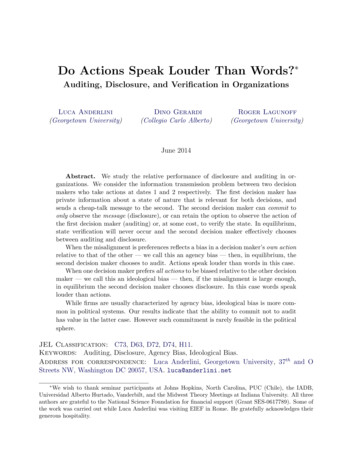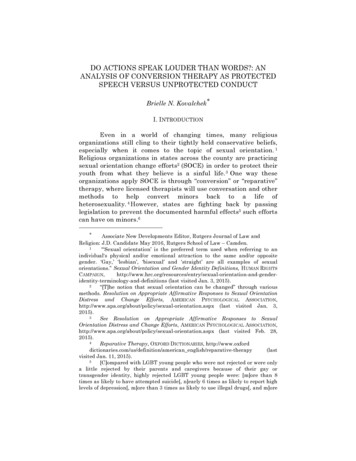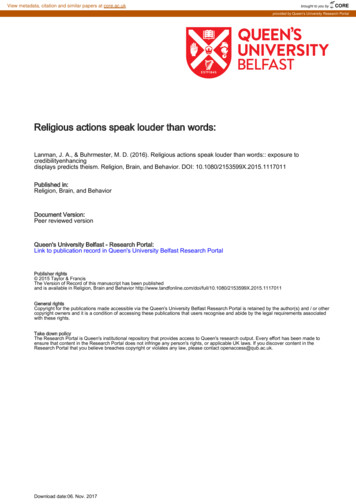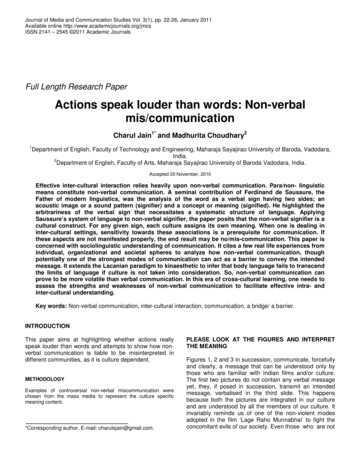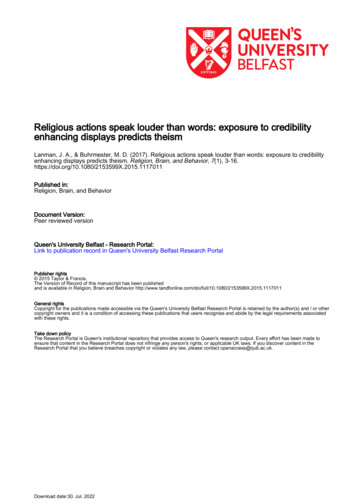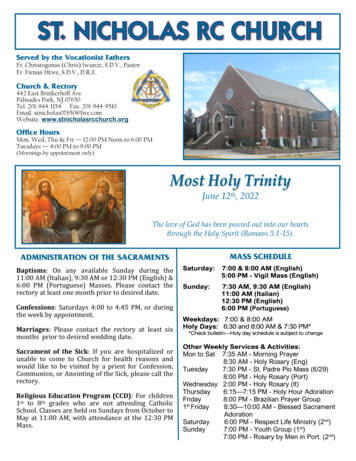
Transcription
Munich Personal RePEc ArchiveDo Actions Speak Louder Than Words?The Response of Asset Prices toMonetary Policy Actions and StatementsGurkaynak, Refet S and Sack, Brian and Swanson, Eric T8 February 2005Online at https://mpra.ub.uni-muenchen.de/820/MPRA Paper No. 820, posted 21 Nov 2006 UTC
Do Actions Speak Louder Than Words?The Response of Asset Prices to MonetaryPolicy Actions and Statements Refet S. Gürkaynak,a,c Brian Sack,b and Eric T. SwansoncaDepartment of Economics, Bilkent University, Ankara, TurkeybMacroeconomic Advisers, LLC, Washington, DCcDivision of Monetary Affairs, Federal Reserve BoardWashington, DCWe investigate the effects of U.S. monetary policy on asset prices using a high-frequency event-study analysis. Wetest whether these effects are adequately captured by a singlefactor—changes in the federal funds rate target—and find thatthey are not. Instead, we find that two factors are required.These factors have a structural interpretation as a “currentfederal funds rate target” factor and a “future path of policy”factor, with the latter closely associated with Federal OpenMarket Committee statements. We measure the effects of thesetwo factors on bond yields and stock prices using a new intraday data set going back to 1990. According to our estimates,both monetary policy actions and statements have importantbut differing effects on asset prices, with statements having amuch greater impact on longer-term Treasury yields.JEL Codes: E52, E58, E43, G14.We thank Ben Bernanke, Ken Kuttner, Jon Faust, Jonathan Wright, twoanonymous referees, and seminar participants at Bilkent, Koç, and Sabancı Universities, the Central Bank of Turkey, and the Federal Reserve Bank of SanFrancisco for valuable discussions, comments, and suggestions. Andrea Surrattand Kunal Gullapalli provided excellent research assistance. The views in thispaper, and any errors and omissions, should be regarded as those of the authors,and do not necessarily reflect those of the individuals listed above, the FederalReserve Board, or any other individual within the Federal Reserve System. Author contact: Refet S. Gürkaynak, Division of Monetary Affairs, Federal ReserveBoard and Department of Economics, Bilkent University, 06800 Ankara, Turkey(e-mail: refet@bilkent.edu.tr). 55
56International Journal of Central BankingMay 2005The Federal Reserve’s announcement following its January 28,2004, policy meeting led to one of the largest reactions in the Treasury market on record, with two- and five-year yields jumping 20and 25 basis points (bp) respectively in the half-hour surroundingthe announcement—the largest movements around any Federal OpenMarket Committee (FOMC) announcement over the fourteen yearsfor which we have data. Even more remarkably, this outsized reaction was spurred not by what the FOMC did, but rather by whatit said : indeed, the decision to leave the current federal funds rateunchanged was completely anticipated by financial markets, but theFOMC’s decision to drop the phrase “policy accommodation can bemaintained for a considerable period” from its accompanying statement and replace it with “the Committee believes it can be patient inremoving its policy accommodation” was read by financial marketsas indicating that the FOMC would begin tightening policy soonerthan previously expected.1 On this date, then, treating the monetarypolicy action as a 0 bp surprise change in the current federal fundsrate target would be missing the whole story.In this paper, we investigate the extent to which this observationis true more generally: are the effects of monetary policy announcements on asset prices adequately characterized by a single factor,namely the surprise component of the change in the current federalfunds rate target? We perform a test of this hypothesis using the ranktest of Cragg and Donald (1997) and strongly reject the hypothesisof a single factor. By contrast, we do not reject the hypothesis thatthe effects of monetary policy on asset prices are characterized bytwo factors. By performing a suitable rotation of these unobservedfactors, we show that they can be given a structural interpretationas a “current federal funds rate target” factor, corresponding to surprise changes in the current federal funds rate target, and a “futurepath of policy” factor, corresponding to changes in futures rates outto horizons of one year that are independent of changes in the currentfunds rate target. We show that this latter (“path”) factor has typically been associated with significant changes in FOMC statements,such as the January 28 example above. In this way, we generalize and1For example, the front page of The Wall Street Journal reported the following morning that “investors interpreted the omission of ‘considerable period’as a signal that the Fed is closer to raising interest rates than many thought”(Ip 2004).
Vol. 1 No. 1Do Actions Speak Louder Than Words?57improve the single-factor analysis of the effects of monetary policyon asset prices performed by earlier authors, such as Cook and Hahn(1989), Kuttner (2001), Cochrane and Piazzesi (2002), Rigobon andSack (2004), Ellingsen and Soderstrom (2003), and Bernanke andKuttner (forthcoming).To measure the effects of monetary policy actions and statementson asset prices, we construct a new data set that captures changesin asset prices in a thirty-minute window and in a one-hour windowbracketing every FOMC announcement going back to 1990 (we usethe term announcement to refer to any means by which a policy decision was communicated to financial markets, including open marketoperations as well as explicit press releases). The use of intraday dataallows us to better isolate the response of asset prices to monetarypolicy announcements, since we can be almost certain that no othereconomic news was released within such a brief interval of time. Thegains from using intraday data are most apparent in the early 1990s,when on a number of occasions the FOMC eased policy just a fewhours after a weak employment report released earlier in the day.In estimating the separate effects of monetary policy actions andstatements, we are not suggesting that FOMC statements representa policy tool that is completely independent of the federal funds ratetarget. In particular, FOMC statements likely exert their effects onfinancial markets through their influence on financial market expectations of future policy actions. Nonetheless, the two-factor approachwe employ in this paper greatly adds to our understanding of theresponse of asset prices to monetary policy announcements—for example, we find that 75 to 90 percent of the explainable variation infive- and ten-year Treasury yields in response to monetary policy announcements is due to the path factor (associated with statements)rather than to changes in the federal funds rate target. We interpretthis result as indicating not that policy actions are secondary so muchas that their influence comes earlier, when investors build in expectations of those actions in response to FOMC statements (and perhapsother events, such as speeches and testimony by FOMC members).Our findings have important implications for the conduct ofmonetary policy in a low-inflation environment. In particular,the fact that FOMC statements have such significant effects onlong-term yields suggests that the FOMC may be able to crediblycommit to future plans for the federal funds rate. Thus, even when
58International Journal of Central BankingMay 2005faced with a low or zero nominal funds rate, our results indicate thatthe FOMC may be able to effectively communicate to the marketsits intention to keep the federal funds rate low for an extendedperiod, thereby lowering longer-term interest rates and stimulatingeconomic growth.2The remainder of the paper proceeds as follows. Section 1 provides a detailed study of surprises in the federal funds rate targetand measures asset price responses to these surpri
set prices using a high-frequency event-study analysis. We test whether these effects are adequately captured by a single factorchanges in the federal funds rate targetand find that . Vol. 1 No. 1 Do Actions Speak Louder Than Words? 57 improve the single-factor analysis of the effects of monetary policy on asset prices performed by earlier .

